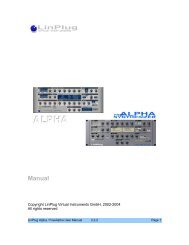SaxLab Manual - LinPlug Virtual Instruments
SaxLab Manual - LinPlug Virtual Instruments
SaxLab Manual - LinPlug Virtual Instruments
You also want an ePaper? Increase the reach of your titles
YUMPU automatically turns print PDFs into web optimized ePapers that Google loves.
What's New in <strong>SaxLab</strong> 2<br />
§ The “Velocity to Envelope” control present in the first version of <strong>SaxLab</strong><br />
has been replaced with a new “Enhance” (ENH) control for enhancing the<br />
attack transients of notes. The “Velocity to Envelope” function (resulting<br />
in a quicker attack upon higher velocity) is still present however it is no<br />
longer adjustable by the user. The new control can be used to improve<br />
the sound of attack transients and increases realism in the case of<br />
staccato or funky sax playing.<br />
§ The Volume, Keys and Air controls, which set the respective levels of the<br />
instrument's three sound layers, are now routed in parallel so that the<br />
relative level of each layer can be independently adjusted.<br />
§ A control named CT (Crossfade Time) has been added to <strong>SaxLab</strong>'s<br />
Performance section. The CT (Crossfade Time) control sets the time<br />
between two legato notes when the smooth fade from the current tone to<br />
the next takes place. The actual time taken is determined by the length of<br />
the previous notes that have been played. This means that the used<br />
Crossfade Time increases for notes with a longer duration and decreases<br />
for notes with a shorter duration. The maximum time is set by the CT<br />
control.<br />
§ The Performance section has been completely reworked and now<br />
contains many more control sources and destinations for real-time<br />
control and expression.<br />
The Performance section features a new MIDI Exp subsection which is a<br />
small modulation matrix customised for sax playing. The MIDI Exp<br />
subsection makes Velocity, Breath Controller, and Aftertouch available<br />
as modulation sources.<br />
Amplitude, Brightness Level, Reverb Mix, as well as a new effect called<br />
“Growl”, are available as modulation destinations. Sensitivity and<br />
mapping curve parameters are available for all modulation destinations.<br />
§ The new Growl effect is designed to reproduce the “growl” sound which<br />
is a typical component of the sound of a saxophone. This effect features<br />
controls for depth and Growl tone can be randomized for more variation.<br />
§ The LFO has been improved and now uses a new waveshape. It also<br />
has a better "attack" characteristic so as to create a more natural sound.<br />
§ The Air parameter now has a dedicated control in the Deviation section.<br />
This means that each note's “Air” component can be randomised,<br />
creating more timbral variation from note to note.<br />
§ The reverb algorithm has been improved so that it sounds more natural.<br />
In addition to this, the Reverb Mix parameter is available as a modulation<br />
destination in the MIDI Exp section.<br />
§ The microtuning system has been updated so that the instrument now<br />
uses standard TUN files. This means that the number of microtuning<br />
systems available for use is vastly increased.<br />
<strong>LinPlug</strong> <strong>SaxLab</strong> User Guide 2.0.3<br />
6












